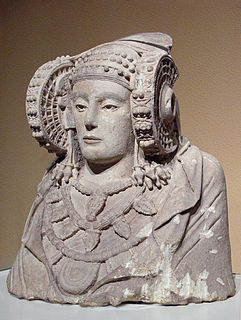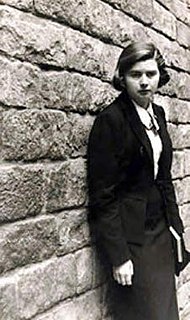
Elche is a city and municipality of Spain, belonging to the province of Alicante, in the Valencian Community. According to 2014 data, Elche has a population of 228,647 inhabitants, making it the third most populated municipality in the region and the 20th largest Spanish municipality. It is part of the comarca of Baix Vinalopó.

The Lady of Elche is a limestone bust that was discovered in 1897, at La Alcudia, an archaeological site on a private estate two kilometers south of Elche, Spain. It is currently exhibited in the National Archaeological Museum of Spain in Madrid.
Dau al Set, the first post-World War II artistic movement in Catalonia, was founded in Barcelona in September 1948 by poet Joan Brossa. The movement, best known for translating the conscious and unconscious mind into art, was heavily influenced by both the Surrealist and Dadaist movements. In Catalan Dau al Set means "the seventh face of the dice", which expresses the movement's rupturist character.

The Palmeral or Palm Grove of Elche is the generic name for a system of date palm orchards in the city of Elche, Spain.
Capella de Ministrers is an early music group formed in 1987 in Valencia, Spain by Carles Magraner. Valencian music is prominent in its repertoire.
Gonzalo Cacicedo Verdú is a Spanish professional footballer who plays for Elche CF as a centre-back.

Víctor Rodríguez Romero is a Spanish professional footballer who plays as a winger for Indian Super League club Odisha.
Francisco Javier Beltrán Manero is a Spanish boccia player, who has represented the country internationally at the Paralympic Games.
Joan Ramón García Castejón, Elche,, known as Joan Castejón is a Spanish draftsman, painter and sculptor, considered one of the leading representatives of social realism in the Spanish postwar plastic renewal. Member of the Grup d'Elx.

Pedro Sánchez Pérez-Castejón is a Spanish politician who has been Prime Minister of Spain since June 2018. He has also been Secretary-General of the Spanish Socialist Workers' Party (PSOE) since June 2017, having previously held that office from 2014 to 2016.
Óscar Pedro Cano Moreno is a Spanish football manager, currently with Deportivo de La Coruña.
Jaume Muxart was a Catalan painter. He was part of the Grup Taüll of avant-garde artists.

José Antonio Pérez Tapias is a Spanish politician, author and university professor. He was a member of the 8th and 9th terms of the Congress of Deputies.

Genoveva Forest Tarrat was a Spanish far-left activist, writer and political prisoner. Born into an anarchist family in Barcelona, she studied medicine in Madrid. During the 1970s, she supported the Basque separatist group ETA in their resistance to the government of dictator Francisco Franco. From 1974 to 1977, she was imprisoned for alleged complicity in the Cafetería Rolando bombing (1974) which killed 13 people in Madrid. After Spain's transition to democracy, she served a term as a senator from 1992 until 1993. The wife of the Spanish writer Alfonso Sastre, she died in May 2007.

Candela Serrat Tiffón is a Spanish actress known to the general public for her participation in the Spanish television series Seis hermanas.








